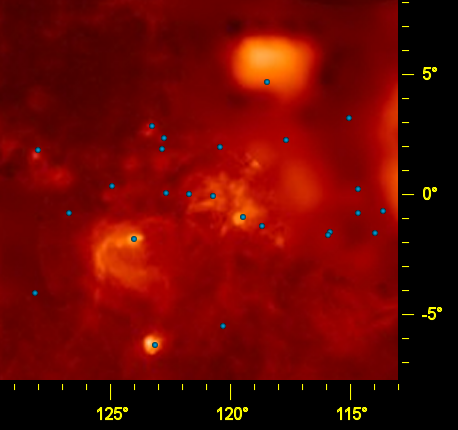
Hover your mouse over each blue dot for the name of the object, or click on the dot for a detail page. This map was created using the all-sky hydrogen-alpha map produced by Douglas Finkbeiner from data collected by the WHAM, VTSS and SHASSA hydrogen-alpha surveys.
The bright nebula above the galactic plane is Sh 2-171, and is associated with the Cepheus OB4 association at a distance of about 840 parsecs. Just a bit further away is Sh 2-187 which appears to be associated with the Cassiopeia OB14 association (and is, confusingly, in the constellation Cassiopeia but at the same distance as the Cepheus region of the Milky Way). The bright region on the left (east) side of the image below the galactic plane is Sh 2-185 which some sources suggest is a reflection nebula, only 240 parsecs away. The size of the nebula in hydrogen-alpha suggests that there may be a much more substantial HII region in this direction however.
Many of the other nebulae on this image (such as Sh 2-173) are associated with a large expanding shell around the Cassiopeia OB5 association at a distance of about 2500 parsecs. Beyond the Cassiopeia region at 2900 parsecs and far below the galactic plane is the Pac-Man nebula (Sh 2-184), which is ionised by a trapezium system (HD 5005) a bit like the one that illuminates the Orion nebula.
There are also several intriguing objects in the same field but much further away in the outer galaxy. These include the large and heavily obscured HII region Sh 2-183 at 7000 parsecs; Sh 2-180, a mysterious filamentary nebula resembling a supernova remnant, at 6100 parsecs; and the recently discovered [TW2004b] Nebula, at 8200 parsecs.
